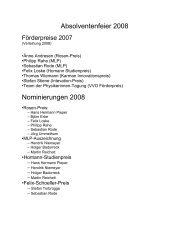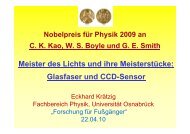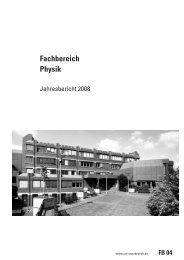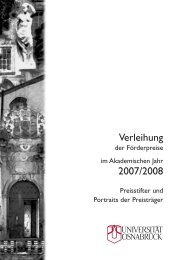Universität Osnabrück, Graduiertenkolleg Mikrostruktur oxidischer
Universität Osnabrück, Graduiertenkolleg Mikrostruktur oxidischer
Universität Osnabrück, Graduiertenkolleg Mikrostruktur oxidischer
Sie wollen auch ein ePaper? Erhöhen Sie die Reichweite Ihrer Titel.
YUMPU macht aus Druck-PDFs automatisch weboptimierte ePaper, die Google liebt.
72 Fig. 3. The amplitude (squares) and frequency<br />
(circles) dependence on the jump rate νJ of (i)<br />
reactants A, J=A (filled interior) and (ii) reactants<br />
B, J=B (open interior). Parameter ζ<br />
=0.065.<br />
UNIVERSITÄT OSNABRÜCK, FACHBEREICH PHYSIK<br />
effective in destroying the oscillatory behavior, because reactants A form clusters and only a portion of reactants<br />
at cluster surfaces can diffuse, whereas most of inner reactants A are screened. In contrast, clusters of reactants B<br />
are more loose due to reactant B annihilation reaction. Thus, reactants B turn out to be more mobile, which<br />
results in more pronounced mobility effects.<br />
(iv) Lastly, the nontrivial case occurs if only reactants A are mobile and we consider the energetic<br />
interaction only between AA, see Fig. 4. Since the Lotka-type model is asymmetric with respect to A and B<br />
reactants, this behavior differs from the case of interacting and mobile reactants B. Now, if we consider an<br />
attraction between reactants AA (e AA 0), the critical concentration of<br />
reactants A should be larger, in order to create a percolating cluster of A’s. Reactants A, which sit on the<br />
surfaces of clusters, repel from reactants A in their NN positions. Thus, a loose structure is formed, which can<br />
accumulate additional reactants A. This process is more time-consuming which is well seen from a decrease of<br />
the frequency for e AA >0, see Fig. 4.<br />
Fig. 4. The amplitude (squares) and frequency<br />
(circles) dependence on the dimensionless energetic<br />
interaction eAA between similar reactants AA.<br />
The jump rate νA=0.14 s -1 , ζ =0.065 and<br />
eAB=eBB=0.<br />
To understand the impact of modulation and diffusion on temporal structures, we have used here a Lotka-type<br />
mathematical model. It allows us to obtain a pictorial view of the basic driving processes. More detailed models<br />
could better reproduce experimentally observed structures. However, the understanding of the mechanisms of<br />
these phenomena in this case is often problematic or even impossible. Therefore, models like the Lotka-type are<br />
of great importance, since they allow to study and understand individual processes, e.g, parameter modulation,<br />
diffusion or energetic interaction, independently of other factors.<br />
Literatur<br />
[1] R. Imbihl and G. Ertl, Chem. Rev. 95, 697 (1995).<br />
[2] M. M. Slin’ko and N. I. Jaeger, Studies in Surface Science and Catalysis, Oscillating Heterogeneous<br />
Catalytic Systems (Elsevier, Amsterdam, 1994), Vol. 86.<br />
[3] M. Eiswirth and G. Ertl, Phys. Rev. Lett. 60, 1526 (1988).<br />
[4] E. V. Albano, Heterog. Chem. Rev. 3, 389 (1996).<br />
[5] E. V. Albano, Surface Science, Computational Methods in Surface and Colloid Science (Marcel Dekker,<br />
Inc.: New York, 2000), Vol. 89, p. 387.<br />
[6] J. Mai, V. N. Kuzovkov, and W. von Niessen, J. Phys. A: Math. Gen. 30, 4171 (1997).<br />
[7] J.-P. Hovi, A. P. J. Jansen, and R. M. Nieminen, Phys. Rev. E 55, 4170 (1997).<br />
[8] A. P. J. Jansen, J. Mol. Catal. A: Chem. 119, 125 (1997).<br />
[9] R. M. Nieminen and A. P. J. Jansen, Appl. Catal. A: Gen. 160, 99 (1997).<br />
[10] E. A. Kotomin and V. N. Kuzovkov, Modern Aspects of Diffusion-Controlled Reactions: Cooperative<br />
Phenomena in Bimolecular Processes (Elsevier, North Holland, Amsterdam, 1996), Vol. 34.<br />
[11] M. Silverberg and A. Ben-Shaul, J. Chem. Phys. 87, 3178 (1987).<br />
[12] J. Mai and W. von Niessen, J. Chem. Phys. 93, 3685 (1990).<br />
[13] I. Jensen and H. C. Fogedby, Phys. Rev. A 42, 1969 (1990).<br />
[14] M. Tammaro, M. Sabella, and J. W. Evans, J. Chem. Phys. 103, 10277 (1995).<br />
[15] R. J. Gelten et al., J. Chem. Phys. 108, 5921 (1998).<br />
[16] H.-P. Kaukonen and R. M. Nieminen, J. Chem. Phys. 91, 4380 (1989).<br />
[17] V. P. Zhdanov, Phys. Rev. E 59, 6292 (1999).<br />
[18] G. Zvejnieks and V. N. Kuzovkov, Phys. Rev. E 61, 4593 (2000).<br />
[19] V. Kashcheyevs (private communication).







